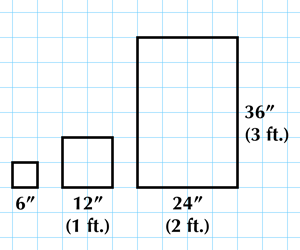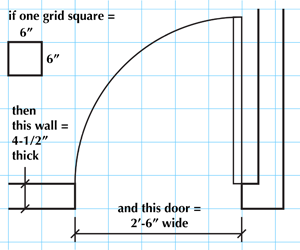How To Draw Pocket Door On Floor Plan
How to Draw a Tiny House Floor Program
on Feb 20, 2022
Whether you're buying a tiny house, working with a tiny house designer, or designing your own, knowing how to draw a flooring plan volition aid you lot communicate your ideas and turn them into a real, workable design.
Getting Started
- Commencement the old-fashioned way. Most great ideas showtime out with a quick sketch on paper. Just a drawing is most useful when it'due south done to scale, assuasive you to sympathise the size of elements and their relationships to each other.
- Graph newspaper makes it easy to draw to calibration. Find graph paper with a not-too-dense grid, or print your ain. Use a pencil, a pen, a magic marking, or whatsoever works for you.

Using the graph paper grid
- Yous'll want each square of the filigree to equal some easy fraction of a pes, like 3", 4", 6", or 1′. Choose one of these (say 6") and multiply it by the number of grid squares on your graph newspaper (say, 30×39). That gives 180×234", or xv×19.v′ (divide inches by 12 to get feet). So, at that calibration on that piece of paper, yous take room to draw something up to 15′ wide and 19′-6" long. A 24" foursquare tabular array would exist iv grid squares long by four filigree squares wide.
- Graph newspaper makes it easy to draw to calibration. Find graph paper with a not-too-dense grid, or print your ain. Use a pencil, a pen, a magic marking, or whatsoever works for you.
- Architectural cartoon software. There are lots of software programs out there, some gratis, some cheap, some very expensive. While professional person designers oftentimes use AutoCAD, you don't need anything so serious. The aforementioned company offers a free, web-based floor programme design tool. If you take had expert (or bad) experiences with other design software, please share it in the comments!
- SketchUp. A lot of tiny house designers have plant SketchUp to be very useful. SketchUp is a free 3D modeling program that is not difficult to learn. With this software, yous tin blueprint not only the floor program but too the full three-dimensional design and details for your tiny business firm. Tutorials are bachelor online, and Michael Janzen from Tiny House Blueprint has done a very helpful video tutorial series on how to draw a tiny house on a trailer with SketchUp.
Knowing how big things are
- Don't forget wall thicknesses. It'due south easy to do, but if you leave out wall thickness in a tiny firm, it adds upwards. If you don't know exactly how thick your walls will be, guess. A typical 2×4 stud wall with 1/2" drywall on either side is four-one/2" thick.

Cartoon a door in a wall
- Know your doors. Residential doors range in size.
- Doors range in width, usually in 2" increments (two′-six", 2′-eight", and and so on). The standard front door on new American houses is 3′ broad and 6′-eight" tall, but this may exist too wide for a tiny house. The old standard front end door size was 2′-8". Consider the size of your largest piece of article of furniture—will it fit in your chosen front end door?
- Brand certain to draw the door swing on the programme. Cheque that the door swing does not hit other doors, fixtures, or furniture. If you have a tight space, consider a pocket door.
- Doors virtually a corner should exist at least 3-4" from the corner to leave space for trim.
- Know your windows. Draw your windows on the program. Windows sizes vary. Common widths, for basic layout of a floor program, are ane′-half dozen", 2′-0", 2′-6", and 3′-0". If windows swing in or out, draw the swing on the plan. For more information on the types and sizes of windows (and doors) out in that location, look at manufacturers like Pella and Jeld-Wen.
- Be realistic nigh furniture. Piece of furniture takes up space. Become out a measuring record and measure your piece of furniture, and yourself sitting in information technology. Or look online for a variety of "standard" dimensions.
- Empathise kitchen dimensions. Kitchen base cabinets are typically 24" deep, with a counter that is 25-1/ii" deep. Typical cabinet widths are in 3" increments (nine", 12", 1′-3", i′-6", etc.). Upper cabinets are typically 12" deep and come in the same widths. Ideally, at least 36" of work space should be allowed in forepart of the cabinets, with 42-48" being more comfortable.
- Understand bath dimensions. Building codes establish some guidelines that are helpful to know, whether or not yous're building to code. For case, there must typically be at to the lowest degree 15" from the center of the toilet to either side wall, for a total of xxx" between walls (although this will be a trivial tight for some people, who may adopt 36"). There should be 21" clear space in front of the toilet.

A realistic floor plan showing walls, doors, windows, kitchen cabinets, fixtures, and article of furniture.
Special considerations
- Plumbing walls. If y'all have a plumbed toilet, the plumber needs to be able to run a vent pipe vertically through information technology, so try to locate information technology near a wall at least 2×4 if not 2×6, and preferably an interior wall.
- Shear walls. In a long, narrow house, side-to-side forces from wind and potentially earthquakes will put the nearly strain on the short end walls. Typically, the sheathing on those walls is what resists these shear forces, so try non to make full these walls entirely with doors and windows that reduce the sheathing area. Also, attempt to keep doors and windows a little abroad from each exterior corner, for extra strength (24" is keen if you tin get it).
- Passive solar design. Orientation and window placement are key aspects of passive solar pattern. Check out my post on passive solar from a couple weeks back for some tips.
Looking for inspiration?
- Look into minor firm books (I recently picked upward Compact Cabins by Gerald Rowan and accept establish it very helpful) or free plans on the internet (such as Michael Janzen'southward free tiny house plans at Tiny Firm Design) for ideas.
- Larn a little bit about feng shui. I don't personally purchase into (or even understand) all the depths of feng shui; that said, I've found it to be useful source of principles for domicile layout and design. About.com has an extensive section on feng shui. Have what you discover useful, ignore what yous don't.
- Simplify, simplify, simplify. A elementary plan is easier to build and may feel less cluttered. It tin be made interesting and beautiful by vertical variation (window and ceiling heights and so on) and cloth choices, and I'll talk about both of those things in the coming weeks.
Note: Last week I announced that this week's article would be about insulation. While that is an interesting topic (at to the lowest degree, if you're a building science geek), information technology's not really specific to tiny houses—the same principles apply to all houses. If you were really looking forward to a thorough discussion of insulation this week, sorry to disappoint—but I'll link to few resources that get into the various options in depth: an article on insulation materials from the Section of Energy
and another on thermal control in buildings from the Building Science Corporation.
Have yous been designing your ain tiny house floor program, or are you non sure where to start? Share your designs, and lessons learned, in the comments beneath! Next calendar week, nosotros'll switch axes and talk about the vertical dimension in tiny houses.
The following two tabs change content beneath.
- Bio
- Latest Posts
Vincent Baudoin is a designer and builder with a background in public interest design, sustainability, and integrated design-build.
Source: https://tinyhousetalk.com/how-to-draw-a-tiny-house-floor-plan/
Posted by: blancharddeve1941.blogspot.com


0 Response to "How To Draw Pocket Door On Floor Plan"
Post a Comment